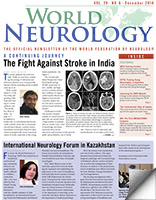
John D. England, MD
By John D. England, MD
The Journal of the Neurological Sciences (JNS) is a broad-based journal that publishes articles from a wide spectrum of disciplines, ranging from basic neuroscience to clinical cases. JNS strives to publish papers with novel, unique and original observations.
Along these lines, members of our Editorial Board are encouraged to identify and foster the submission of manuscripts that demonstrate the highest quality research. We also strive to satisfy the desires and needs of our readership, and I have received many requests to increase the number of review articles that cover topics in clinical neurology as well as basic neuroscience.
JNS has always welcomed well written and relevant review articles, and I wish to re-emphasize this point to prospective authors. Dr. Daniel Truong, who is the associate editor for Reviews and Commentary, has updated the suggested format for review articles submitted to JNS.
Whatever the topic, the review should be richly referenced and include summary text boxes, tables and diagrams or figures. The idea is to make the reviews easily readable and educational. Authors who might be interested in writing and submitting review articles to JNS can find specific requirements and suggestions within the JNS website.
In our ongoing attempt to enhance accessibility of JNS articles to members of the World Federation of Neurology (WFN), we have selected two more “free-access” articles, which are profiled in this issue of World Neurology.
In this issue, we feature two paired articles regarding the ALS-Plus syndrome.
- Many clinical and pathological studies indicate that ALS is a more heterogeneous disease than previously recognized. In fact, even patients who appear to exhibit a clinically pure motor system disease often have neuropathological evidence of multisystem disease. In the largest series of cases to date, Leo McCluskey, et al, assessed the frequency of the “ALS-Plus” syndrome in a consecutively ascertained series of 550 patients with ALS. Their criteria for ALS-Plus was a clinical diagnosis of ALS combined with deficits of ocular motility, cerebellar signs, extrapyramidal features or autonomic dysfunction. Cognitive impairment was also assessed, but determined separately. Selected patients had genetic testing and high-resolution MRI of brain. Seventy-five (13.6%) patients had ALS-Plus syndrome. Fourteen additional patients had evidence of cognitive deficit (ALS-FTD). Cognitive impairment, bulbar-onset and pathogenic genetic mutations were more common in the patients with ALS-Plus syndrome compared to patients without ALS-Plus syndrome. The patients with ALS-Plus syndrome also had a shorter survival.
McCluskey L, Vandriel S, Elman L, Van Deerlin VM, Powers J, Boller A, et al. ALS-Plus syndrome: Non-pyramidal features in a large ALS cohort. J Neurol Sci 2014;345:118-124. - In an accompanying editorial, Benjamin Brooks provides an historical perspective and comments upon the importance of the article for the field of ALS research. He determines that McCluskey and colleagues have performed a “masterful clinical study of a modern series of ALS-Plus from a single center.” He suggests that this study provides a clinical framework for accurate classification of ALS-Plus syndrome. Studies such as this one indicate that “atypical” ALS is not as atypical as we believed and should stimulate more thought and research within the field.
Brooks BR. ALS-Plus – Where does it begin, where does it end? J Neurol Sci 2014;345:1-2.
